-

大班数学游戏教案:城堡夺旗(8的分合法)
准备:数字卡 棋盘 不同颜色的棋子 旋转六面体 各色旗 扑克牌 玩法:每组5名幼儿,一幅棋盘,每位幼儿一套1——7的扑克牌,每名幼儿持一粒不同颜色的棋子,将各自的棋子放在起点,按照自己的标志次序轮流掷旋转六面体,掷出数字几,就向前走几步,如果走到没有图案的格内,就让下一位幼儿掷旋转六面体;如果走到有图案的格子内,就大声说出图案的数量,并向其他幼儿提问该数字和哪一个数字合起来是8,然后与同伴一起从自己的数字卡中拿出相应的数字卡,拿对的幼儿向前走一步,拿错的幼儿原地不动,看谁先走到终点,谁就在城堡的最底层插一面与自己棋子颜色相同的彩旗。游戏反复进行,谁的彩旗第一个到达城堡的顶端,谁就取得胜利。
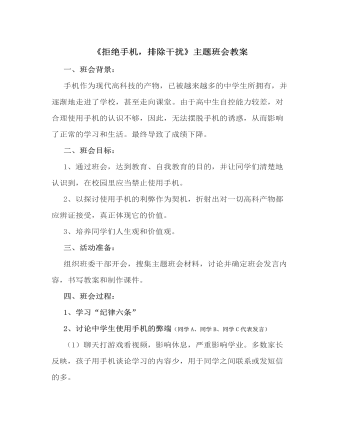
《拒绝手机,排除干扰》主题班会教案
一、班会背景:手机作为现代高科技的产物,已被越来越多的中学生所拥有,并逐渐地走进了学校,甚至走向课堂。由于高中生自控能力较差,对合理使用手机的认识不够,因此,无法摆脱手机的诱惑,从而影响了正常的学习和生活。最终导致了成绩下降。二、班会目标:1、通过班会,达到教育、自我教育的目的,并让同学们清楚地认识到,在校园里应当禁止使用手机。2、以探讨使用手机的利弊作为契机,折射出对一切高科产物都应辨证接受,真正体现它的价值。3、培养同学们人生观和价值观。三、活动准备:组织班委干部开会,搜集主题班会材料,讨论并确定班会发言内容,书写教案和制作课件。四、班会过程:1、学习“纪律六条”2、讨论中学生使用手机的弊端(同学A、同学B、同学C代表发言)(1)聊天打游戏看视频,影响休息,严重影响学业。多数家长反映,孩子用手机谈论学习的内容少,用于同学之间联系或发短信的多。
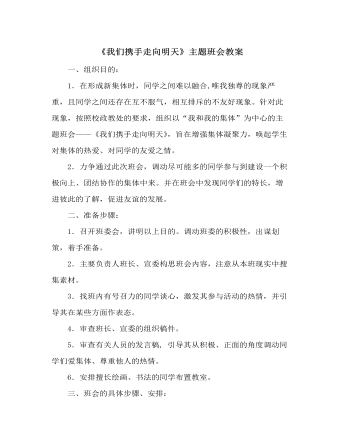
《我们携手走向明天》主题班会教案
一、组织目的:1.在形成新集体时,同学之间难以融合,唯我独尊的现象严重,且同学之间还存在互不服气,相互排斥的不友好现象。针对此现象,按照校政教处的要求,组织以“我和我的集体”为中心的主题班会——《我们携手走向明天》,旨在增强集体凝聚力,唤起学生对集体的热爱、对同学的友爱之情。2.力争通过此次班会,调动尽可能多的同学参与到建设一个积极向上、团结协作的集体中来。并在班会中发现同学们的特长,增进彼此的了解,促进友谊的发展。 二、准备步骤:1.召开班委会,讲明以上目的。调动班委的积极性,出谋划策,着手准备。 2.主要负责人班长、宣委构思班会内容,注意从本班现实中搜集素材。3.找班内有号召力的同学谈心,激发其参与活动的热情,并引导其在某些方面作表态。4.审查班长、宣委的组织稿件。5.审查有关人员的发言稿, 引导其从积极、正面的角度调动同学们爱集体、尊重他人的热情。
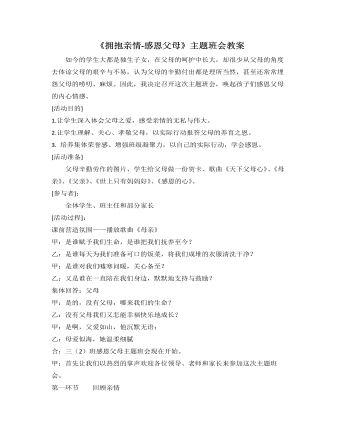
《拥抱亲情-感恩父母》主题班会教案
“正好啊,老树根是最适合坐下来休息的。来啊!孩子,坐下,快坐下来休息一下。”男孩坐了下来。树好快乐。她高兴得留下了流下了泪水……(故事结束后,课件出示父母辛苦劳作的图片,出示一组家庭生活图片,学生思考感悟。)请学生谈由图片和歌曲获得的感受和体会:“你想到了什么”?学生自由发言。甲:这就是我们的父母,他们无怨无悔,不求回报,真是可怜“天下父母心”啊!播放歌曲《天下父母心》:然而在日常生活中,我们总会与父母发生分歧甚至冲突顶撞,还常常埋怨父母的啰嗦。我们的母亲因为儿子的顽皮而无奈的哭泣;我们的父亲因为女儿的懒惰而叹气;请看小品:《丁丁在家里》(由部分学生和家长代表合演,主要凸显月休孩子在家不听父母教导,过于沉迷网络游戏,不写作业,不能按时作息而家长无可奈何的现象)。
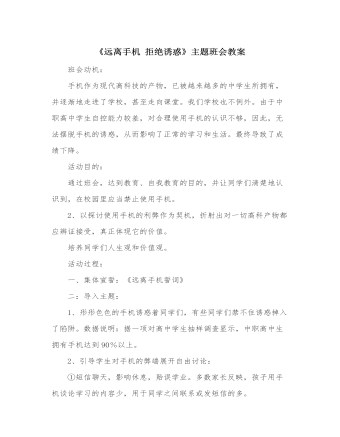
《远离手机 拒绝诱惑》主题班会教案
⑦使用手机会妨碍学校的教育教学秩序。上课时有的同学手机未关机,突然来电话,影响全体同学听课。会给整个教室带来不愉快的情绪。⑧手机对人有辐射。许多广告只说手机有多少多少先进功能,却从未提对人体伤害。对人体是否造成不利的影响,医学界可谓众说纷纭,最近权威医学杂志《柳叶刀》的手机报告显示,使用手机造成记忆力受损、睡眠紊乱、头痛、癞痫及血压上升的现象,而儿童,青少年受影响的可能更大。大部分国家通用的手机系统GSM频率为900和1800MHz,其振动的电子过程有机会对人体健康造成影响,主要是对脑部及精神状态的影响. 而且手机振动所散发出的电磁波可能会导致青少年大脑的神经出现病变。青少年正处在生长发育的黄金阶段,如果因为手机而对身体伤害,岂不追悔莫及。
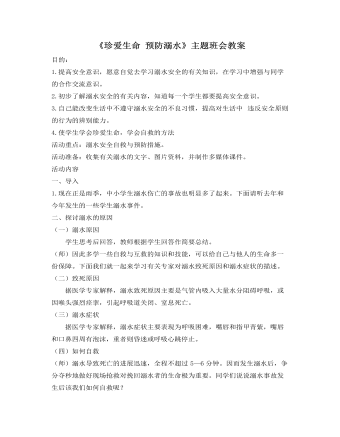
《珍爱生命 预防溺水》 主题班会教案
(2)如何开展岸上急救 第一步:当溺水者被救上岸后,应立即将其口腔打开,清除口腔中的分泌物及其他异物。如果溺水者牙关紧闭,要从其后面用两手的拇指由后向前顶住他的下颌关节,并用力向前推进。同时,两手的食指与中指向下扳颌骨,即可搬开他的牙关。 第二步:控水。救护者一腿跪地,另一腿屈膝,将溺水者的腹部放到屈膝的大腿上,一手扶住他的头部,使他的嘴向下,另一手压他的背部,这样即可将其腹内水排出。 第三步:如果溺水者昏迷,呼吸微弱或停止,要立即进行人工呼吸,通常采用口对口吹气的方法效果较好。若心跳停止还应立即配合胸部按压,进行心脏复苏。心肺复苏的目的在于尽快挽救脑细胞,避免因缺氧引起细胞坏死。因此施救越快越好,同时注意要在急救的同时,要迅速打急救电话,或拦车送医院。
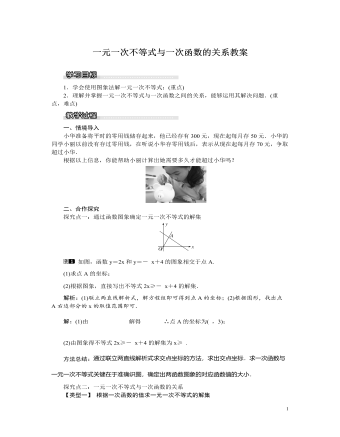
北师大初中八年级数学下册一元一次不等式与一次函数的关系教案
解析:先利用正比例函数解析式确定A点坐标,然后观察函数图象得到,当1<x<2时,直线y=2x都在直线y=kx+b的上方,于是可得到不等式0<kx+b<2x的解集.把A(x,2)代入y=2x得2x=2,解得x=1,则A点坐标为(1,2),∴当x>1时,2x>kx+b.∵函数y=kx+b(k≠0)的图象经过点B(2,0),即不等式0<kx+b<2x的解集为1<x<2.故选C.方法总结:本题考查了一次函数与一元一次不等式的关系:从函数的角度看,就是寻求使一次函数y=ax+b的值大于(或小于)0的自变量x的取值范围;从函数图象的角度看,就是确定直线y=kx+b在y轴上(或下)方部分所有的点的横坐标所构成的集合.三、板书设计1.通过函数图象确定一元一次不等式的解集2.一元一次不等式与一次函数的关系本课时主要是掌握运用一次函数的图象解一元一次不等式,在教学过程中采用讲练结合的方法,让学生充分参与到教学活动中,主动、自主的学习.
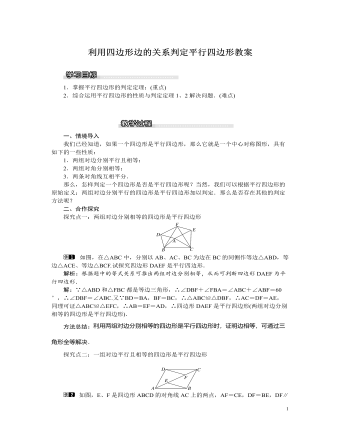
北师大初中八年级数学下册利用四边形边的关系判定平行四边形教案
解:四边形ABCD是平行四边形.证明如下:∵DF∥BE,∴∠AFD=∠CEB.又∵AF=CE,DF=BE,∴△AFD≌△CEB(SAS),∴AD=CB,∠DAF=∠BCE,∴AD∥CB,∴四边形ABCD是平行四边形.方法总结:此题主要考查了平行四边形的判定,以及三角形全等的判定与性质,解题的关键是根据条件证出△AFD≌△CEB.三、板书设计1.平行四边形的判定定理(1)两组对边分别相等的四边形是平行四边形.2.平行四边形的判定定理(2)一组对边平行且相等的四边形是平行四边形.在整个教学过程中,以学生看、想、议、练为主体,教师在学生仔细观察、类比、想象的基础上加以引导点拨.判定方法是学生自己探讨发现的,因此,应用也就成了学生自发的需要,用起来更加得心应手.在证明命题的过程中,学生自然将判定方法进行对比和筛选,或对一题进行多解,便于思维发散,不把思路局限在某一判定方法上.
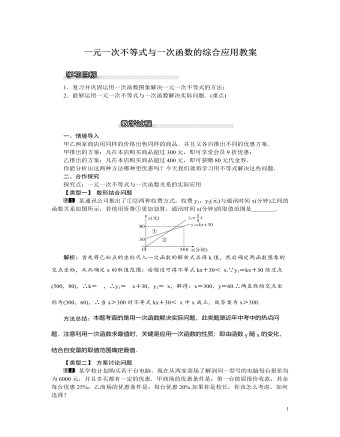
北师大初中八年级数学下册一元一次不等式与一次函数的综合应用教案
解析:(1)根据题设条件,求出等量关系,列一元一次方程即可求解;(2)根据题设中的不等关系列出相应的不等式,通过求解不等式确定最值,求最值时要注意自变量的取值范围.解:设购进A种树苗x棵,则购进B种树苗(17-x)棵,(1)根据题意得80x+60(17-x)=1220,解得x=10,所以17-x=17-10=7,答:购进A种树苗10棵,B种树苗7棵;(2)由题意得17-x172,所需费用为80x+60(17-x)=20x+1020(元),费用最省需x取最小整数9,此时17-x=17-9=8,此时所需费用为20×9+1020=1200(元).答:购买9棵A种树苗,8棵B种树苗的费用最省,此方案所需费用1200元.三、板书设计一元一次不等式与一次函数关系的实际应用分类讨论思想、数形结合思想本课时结合生活中的实例组织学生进行探索,在探索的过程中渗透分类讨论的思想方法,培养学生分析、解决问题的能力,从新课到练习都充分调动了学生的思考能力,为后面的学习打下基础.
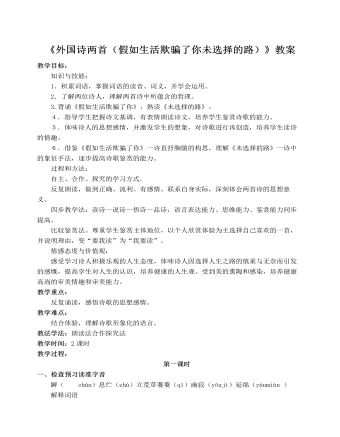
部编版语文七年级下册《外国诗两首(假如生活欺骗了你 未选择的路)》教案
写作背景这首诗写于普希金被沙皇流放的日子里,是以赠诗的形式写在他的邻居奥希泊娃的女儿叶甫勃拉克西亚·尼古拉耶夫娜·伏里夫纪念册上的。那里俄国革命正如火如荼,诗人却被迫与世隔绝。在这样的处境下,诗人却没有丧失希望与斗志,他热爱生活,执着地追求理想,相信光明必来,正义必胜。(三)、问题探究1、“假如生活欺骗了你”指的是什么?指在生活中因遭遇艰难困苦甚至不幸而身处逆境。作者写这首诗时正被流放,是自己真实生活的写照。2、诗人在诗中阐明了怎样的人生态度?请结合你感受最深的诗句说说你曾有过的体验。诗中阐明了这样一种积极乐观的人生态度:当生活欺骗了你时,不要悲伤,不要心急;在苦恼的时候要善于忍耐,一切都会过去,我们一定要永葆积极乐观的心态;生活中不可能没有痛苦与悲伤,欢乐不会永远被忧伤所掩盖,快乐的日子终会到来。
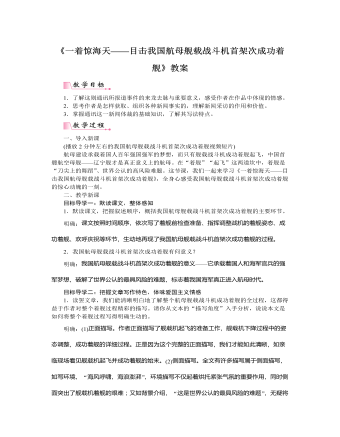
部编版语文八年级上册《一着惊海天——目击我国航母舰载战斗机首架次成功着舰》教案
2.为了表现出我国航母舰载战斗机首架次成功着舰时惊心动魄的气势,表现出舰载机成功着舰后国人的喜悦,作者在语言上也下了一番功夫,请你结合课文做具体分析。明确:(1)运用修辞手法,描绘着舰场面。“声如千骑疾,气卷万山来。”运用对偶、夸张和比喻的修辞手法,增强文章气势,生动形象地表现了舰载机着舰时的浩大声势,具有感染力。(2)运用细节描写,生动形象地描绘出舰载机着舰的情形。如“震耳欲聋”“轰鸣”描绘出舰载机着舰时巨大的声音,“眨眼之间”“刹那间”“疾如闪电”等词描绘出舰载机着舰时的震撼场面。“牢牢地”“稳稳地”生动地写出了我国舰载机着舰技术的成熟和飞行员操作技能的娴熟。“定格了一个象征胜利的巨大‘V’字”的特写镜头,既是对当时情景的生动再现,也表现了作者对我国航母舰载战斗机首架次成功着舰的喜悦和自豪。
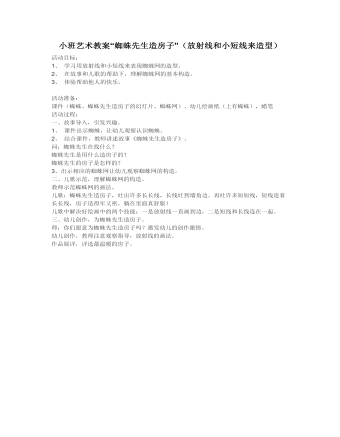
小班艺术教案“蜘蛛先生造房子”(放射线和小短线来造型
2、 在故事和儿歌的帮助下,理解蜘蛛网的基本构造。 3、 体验帮助他人的快乐。 活动准备: 课件(蜘蛛、蜘蛛先生造房子的幻灯片、蜘蛛网)、幼儿绘画纸(上有蜘蛛),蜡笔 活动过程: 一、故事导入,引发兴趣。 1、 课件出示蜘蛛,让幼儿观察认识蜘蛛。 2、 结合课件,教师讲述故事《蜘蛛先生造房子》。 问:蜘蛛先生在找什么? 蜘蛛先生是用什么造房子的? 蜘蛛先生的房子是怎样的? 3、出示相应的蜘蛛网让幼儿观察蜘蛛网的构造。
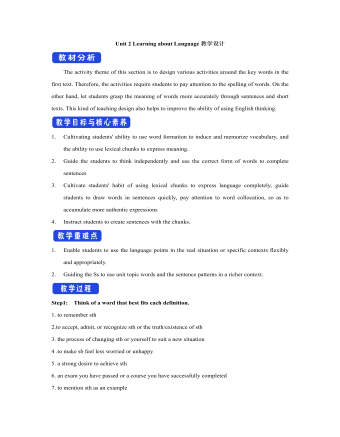
新人教版高中英语选修2Unit 2 Learning about Language教学设计
The activity theme of this section is to design various activities around the key words in the first text. Therefore, the activities require students to pay attention to the spelling of words. On the other hand, let students grasp the meaning of words more accurately through sentences and short texts. This kind of teaching design also helps to improve the ability of using English thinking.1. Cultivating students' ability to use word formation to induce and memorize vocabulary, and the ability to use lexical chunks to express meaning.2. Guide the students to think independently and use the correct form of words to complete sentences3. Cultivate students' habit of using lexical chunks to express language completely, guide students to draw words in sentences quickly, pay attention to word collocation, so as to accumulate more authentic expressions4. Instruct students to create sentences with the chunks.1. Enable students to use the language points in the real situation or specific contexts flexibly and appropriately.2. Guiding the Ss to use unit topic words and the sentence patterns in a richer context.Step1: Think of a word that best fits each definition.1. to remember sth2.to accept, admit, or recognize sth or the truth/existence of sth3. the process of changing sth or yourself to suit a new situation4 .to make sb feel less worried or unhappy5. a strong desire to achieve sth
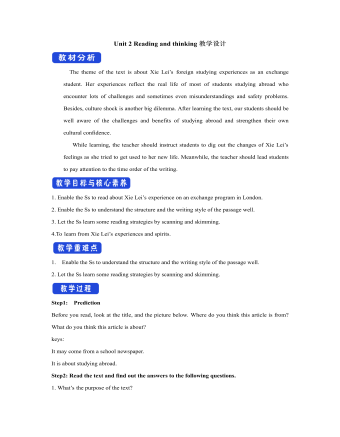
新人教版高中英语选修2Unit 2 Reading and thinking教学设计
Her tutor told her to acknowledge __________ other people had said if she cited their ideas, and advised her _______(read) lots of information in order to form __________wise opinion of her own.Now halfway __________ her exchange year, Xie Lei felt much more at home in the UK. She said __________ (engage) in British culture had helped and that she had been__________ (involve) in social activities. She also said while learning about business, she was acting as a cultural messenger __________(build) a bridge between the two countries. keys:Xie Lei, a 19yearold Chinese student, said goodbye to her family and friends in China and boarded (board) a plane for London six months ago in order to get a business qualification. She was ambitious(ambition) to set up a business after graduation. It was the first time that she had left (leave) home.At first, Xie Lei had to adapt to life in a different country. She chose to live with a host family, who can help with her adaptation (adapt) to the new culture. When she missed home, she felt comforted (comfort) to have a second family. Also Xie Lei had to satisfy academic requirements. Her tutor told her to acknowledge what other people had said if she cited their ideas, and advised her to read lots of information in order to form a wise opinion of her own.Now halfway through her exchange year, Xie Lei felt much more at home in the UK. She said engaging (engage) in British culture had helped and that she had been involved (involve) in social activities. She also said while learning about business, she was acting as a cultural messenger building a bridge between the two countries.
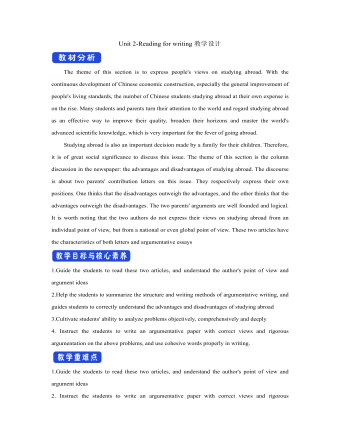
新人教版高中英语选修2Unit 2 Reading for writing教学设计
The theme of this section is to express people's views on studying abroad. With the continuous development of Chinese economic construction, especially the general improvement of people's living standards, the number of Chinese students studying abroad at their own expense is on the rise. Many students and parents turn their attention to the world and regard studying abroad as an effective way to improve their quality, broaden their horizons and master the world's advanced scientific knowledge, which is very important for the fever of going abroad. Studying abroad is also an important decision made by a family for their children. Therefore, it is of great social significance to discuss this issue. The theme of this section is the column discussion in the newspaper: the advantages and disadvantages of studying abroad. The discourse is about two parents' contribution letters on this issue. They respectively express their own positions. One thinks that the disadvantages outweigh the advantages, and the other thinks that the advantages outweigh the disadvantages. The two parents' arguments are well founded and logical. It is worth noting that the two authors do not express their views on studying abroad from an individual point of view, but from a national or even global point of view. These two articles have the characteristics of both letters and argumentative essays1.Guide the students to read these two articles, and understand the author's point of view and argument ideas2.Help the students to summarize the structure and writing methods of argumentative writing, and guides students to correctly understand the advantages and disadvantages of studying abroad3.Cultivate students' ability to analyze problems objectively, comprehensively and deeply
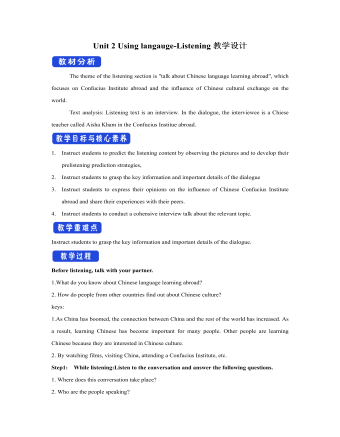
新人教版高中英语选修2Unit 2 Using langauge-Listening教学设计
? B: Absolutely! Getting involved with Chinese cultural activities there definitely helped a lot. I got to practice my Chinese on a daily basis, and I could learn how native Chinese speakers spoke.? A: What do you feel is your biggest achievement?? B: Learning Chinese characters! I have learnt about 1,500 so far. When I first started, I didn't think it was even going to be possible to learn so many, but now I find that I can read signs, menus, and even some easy newspaper articles.? A: What are you most keen on?? B: I've really become keen on learning more about the Chinese culture, in particular Chinese calligraphy. As I have learnt Chinese characters, I have developed a great appreciation for their meaning. I want to explore Chinese characters by learning how to write them in a more beautiful way. ? A: Finally, what do you want to say to anyone interested in learning Chinese?? I have really become keen on learning more about the Chinese culture, in particular Chinese Calligraphy. As I have learnt Chinese character, I have developed a great appreciation for their meaning. I want to explore Chinese characters by learning how to write them in a more beautiful way.? A: Finally, what do you want to say to anyone interested in learning Chinese?? B: I'd say, give it a shot! While some aspects may be difficult, it is quite rewarding and you will be happy that you tried.? A: Thanks for your time. ? B:You're welcome.
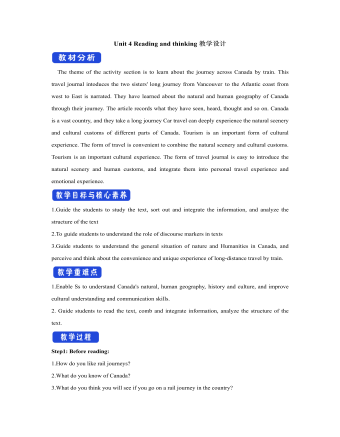
新人教版高中英语选修2Unit 4 Reading and thinking教学设计
【词汇精讲】highlight n.最好或最精彩的部分 vt.突出;强调;使醒目One of the highlights of the trip was seeing the Taj Mahal.这次旅行的亮点之一是参观泰姬陵。Your resume should highlight your skills and achievements.你的简历应该突出你的技能和成就。The report highlights the major problems facing society today.报告强调了当今社会所面临的主要问题。I’ve highlighted the important passages in yellow.我用黄色标出了重要段落。7.Edmonton is freezing cold in winter,with daily temperatures averaging -10 ℃.埃德蒙顿冬季寒冷,日平均气温为-10°C。【词汇精讲】freezing adj.极冷的;冰冻的Leave a basin of water outside in freezing weather.在冰冻的天气里,放一盆水在室外。It’s freezing cold outside so wear a warm coat.外面超冷的,所以穿一个暖和一点的外套吧。8.It was not until 9:30 a.m.that they finally reached the capital of Ontario,Toronto.直到上午9时30分,他们才终于到达多伦多的首府安大略省。【句式剖析】本句是一个强调句,强调的是句子的时间状语until 9:30。含有not...until...的句子的强调句为It is not until...that...,that后面的句子要用肯定形式。It was not until then that I suddenly realized nobody was happier than I was.直到那时我才突然意识到没有人比我更幸福了。
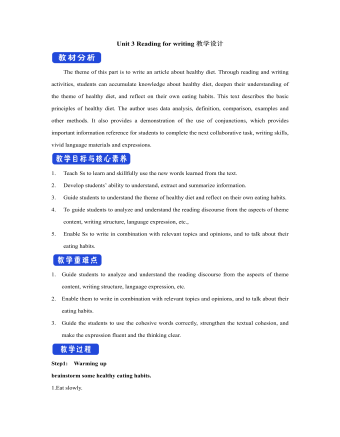
新人教版高中英语选修2Unit 3 Reading for writing教学设计
The theme of this part is to write an article about healthy diet. Through reading and writing activities, students can accumulate knowledge about healthy diet, deepen their understanding of the theme of healthy diet, and reflect on their own eating habits. This text describes the basic principles of healthy diet. The author uses data analysis, definition, comparison, examples and other methods. It also provides a demonstration of the use of conjunctions, which provides important information reference for students to complete the next collaborative task, writing skills, vivid language materials and expressions.1. Teach Ss to learn and skillfully use the new words learned from the text.2. Develop students’ ability to understand, extract and summarize information.3. Guide students to understand the theme of healthy diet and reflect on their own eating habits.4. To guide students to analyze and understand the reading discourse from the aspects of theme content, writing structure, language expression, etc., 5. Enable Ss to write in combination with relevant topics and opinions, and to talk about their eating habits.1. Guide students to analyze and understand the reading discourse from the aspects of theme content, writing structure, language expression, etc.2. Enable them to write in combination with relevant topics and opinions, and to talk about their eating habits.3. Guide the students to use the cohesive words correctly, strengthen the textual cohesion, and make the expression fluent and the thinking clear.Step1: Warming upbrainstorm some healthy eating habits.1.Eat slowly.2.Don’t eat too much fat or sugar.3.Eat healthy food.4.Have a balanced diet.Step2: Read the passage and then sum up the main idea of each paragraph.

新人教版高中英语选修2Unit 4 Learning about Language教学设计
This section guides students to pay attention to the typical context of vocabulary use, helps students accumulate vocabulary around the key vocabulary of this unit, and uses the learned words and word chunks in different contexts to deeply understand their meaning and usage, so as to achieve the purpose of review and consolidation.The teaching design activities aim to guide students to pay attention to the typical context in which the target vocabulary is used, as well as the common vocabulary used in collocation, so that students can complete the sentence with correct words. In terms of vocabulary learning strategies, this unit focuses on cultivating students' ability to pay attention to collocation of words and to use word blocks to express meaning.For vocabulary learning, it is not enough just to know the meaning of a single word, but the most important thing is to master the common collocations of words, namely word blocks.Teachers should timely guide students to summarize common vocabulary collocation, such as verb and noun collocation, verb and preposition collocation, preposition and noun collocation, and so on.1. Guide students to understand and consolidate the meaning and usage of the vocabulary in the context, 2. Guide the students to use the unit topic vocabulary in a richer context3. Let the students sort out and accumulate the accumulated vocabulary, establishes the semantic connection between the vocabulary,4. Enable students to understand and master the vocabulary more effectivelyGuiding the Ss to use unit topic words and the sentence patterns in a richer context.

新人教版高中英语选修2Unit 5 Using langauge-Listening教学设计
The theme of this section is to learn how to make emergency calls. Students should learn how to make emergency calls not only in China, but also in foreign countries in English, so that they can be prepared for future situations outside the home.The emergency telephone number is a vital hotline, which should be the most clear, rapid and effective communication with the acute operator.This section helps students to understand the emergency calls in some countries and the precautions for making emergency calls. Through the study of this section, students can accumulate common expressions and sentence patterns in this context. 1.Help students accumulate emergency telephone numbers in different countries and learn more about first aid2.Guide the students to understand the contents and instructions of the telephone, grasp the characteristics of the emergency telephone and the requirements of the emergency telephone.3.Guide students to understand the first aid instructions of the operators.4.Enable Ss to make simulated emergency calls with their partners in the language they have learned1. Instruct students to grasp the key information and important details of the dialogue.2. Instruct students to conduct a similar talk on the relevant topic.Step1:Look and discuss:Match the pictures below to the medical emergencies, and then discuss the questions in groups.